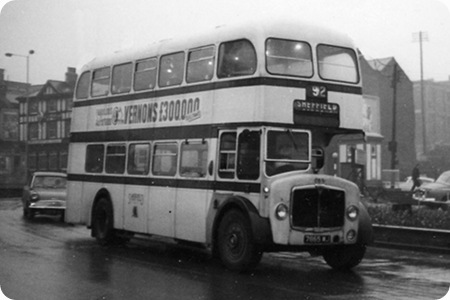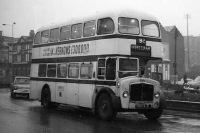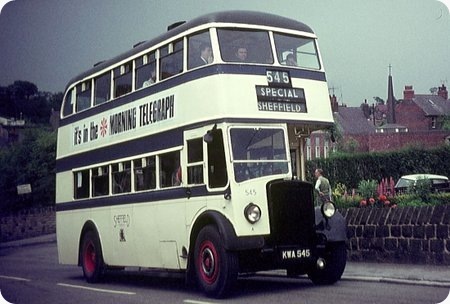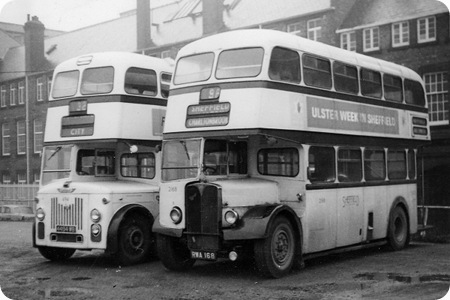
Sheffield Corporation
1960
AEC Regent V 2D3RA
Alexander H37/28R
This photo was taken just after lunch but as you can see this Regent V has the interior lights on, what a miserable day that was. I know this is not a very good shot but it is worth posting due to the fact that most Alexander bodied Regent Vs were delivered north of the border with the majority of them being to Glasgow Corporation. I think this vehicle one of a batch of 20 delivered to the Sheffield “A” fleet were the only ones delivered new to an English operator, if I am incorrect I am sure someone will let me know.
Sheffield like quite a few municipalities had separate fleets wholly or jointly owned within the overall operation.
Sheffield had three fleets A, B and C and were owned as follows.
“A” fleet Corporation owned (fleet numbers 1-999 in 1965)
“B” fleet Jointly owned by the Corporation and British Railways (fleet numbers 1251-1400 in 1965)
“C” fleet British Railways owned (fleet numbers 1150-1250 in 1965)
If you want to know the full specification for the Regent V 2D3RA you can look it up under the Regent V abbreviations here.
———
The only operator of this style of Alexander outside Scotland to predate them was Cardiff – definitely not England.
861 – 880 were the precursors of many Alexander bodies for STD, SYPTE and then Mainline. They looked good, and being AECs were good and sounded good. For some reason, the numbers didn’t add up. The Weymann and Roe 2D3RAs were all H39/30R(D – Roe) with bags of leg room. The Alexanders were H37/32R and whilst lack of legroom downstairs was understandable, what wasn’t was the distinct lack of room with fewer seats upstairs.
I have an unsubstantiated theory about the design – can anyone confirm, or squash it? Many 1940/50s Alexander deckers were built on Weymann (pre Orion) frames before this design emerged. Is it too fanciful to suggest that it was based on the same design and frames as the Rochdale Regent Vs and Sheffield Regent IIIs and Titan PD2s? [Curved domes and side windows?]
This Regent is on route 92 Manor Park – very close to the City Centre and would normally have had City on the blind. The photograph looks as if it was taken very close to the new Supertram depot and Park and Ride site which was not a regular haunt for these Regents. When new they could be seen on the 95 and 75 tram replacement routes and also drifted onto 60 and 38. Was this taken late in its life? The Alexanders and Roes were divided between Leadmill and East Bank garages, the Weymanns were all, I think, at East Bank.
874 was immaculately restored some years ago and is a regular on the northern rally circuit. But (trivia time), why did the last one (880) have a different type and style of rear number plate? I don’t know! If you know please leave a comment.
David Oldfield
———
02/03/11
Enjoyed the posting and the comment from David Oldfield with respect to the Alexander bodied Regent V’s. I must confess to liking the Weymanns a bit more, but the Scottish bodies certainly stood out with that rounded dome.
When still relatively new, I remember these Alexanders often making a Saturday appearance on the 34 Petre Street – Graves Park, along with some of the Weymann ones, running from East Bank, and they looked even more unusual on there, alongside the 1947 vintage Weymann bodied Regent III’s of the 558-572 batch that were still the mainstay of this service at the time. In fact two 30 footers arriving at Reform Chapel within minutes of each other was apt to cause a bit of a problem, as there wasn’t a lot of room to spare at the bus stop alongside the chapel opposite the chip shop!
I think the reason for 880 having a different rear end, with the registration plate in the standard position at the offside corner was that it had a rear end collision at some point, and emerged from Queens Road after repair in the altered state, thus making it unique in the batch.
When new, a colleague informs me that all the Alexanders initially went to Bramall Lane for the 33 and the 75 tram replacement routes, with the 26 Weymanns being split between Bramall Lane and Leadmill Road. Noteworthy on the Alexanders was the first offside window behind the cab being a hinged emergency escape window, something which of course the Weymanns didn’t have.
At least three of those superb Roe bodied ones were at Townhead Street when new, for use on the 85 to Retford, and also on the Dinnington services, where their platform doors were no doubt very well received, especially in the cold weather. The story has it that the Roe bodies initially lacked a centre stanchion on the platform, these being fitted sometime later after an unfortunately fatal accident which was attributed to the lack of a grab pole. More trivia!
Dave Careless
———
03/03/11 – 08:53
Dave. Thanks for filling in the allocation details. Townhead Street and Branhall Lane were operational when I was very young but had closed by the time I became really interested. I had forgotten, but you are absolutely right in every respect about the Roe centre stanchion and the fatality.
David Oldfield
———
04/03/11 – 07:39
Thanks David, I’m pleased you found that of interest.
Those Roe bodied Regent V’s were wonderful machines, I always felt they looked a lot more elegant when they were new, with the standard Roe version of the Sheffield livery, with the blue window surrounds, and the classy bodybuilders gold transfer on the waistband, at the side of the cab and just forward of the entrance, very smart indeed. And the styling of that Roe emergency window simply couldn’t be beat!
After Chaceley T. Humpidge took over as General Manager in 1961, and did away with the livery variations, including the grey roof after first overhaul (not that any of 1325-1349 ever saw this application), the Roes never looked quite as smart in the standard cream with blue bands, but that’s merely a personal preference.
It’s a pity that you missed Townhead Street in its heyday, as that was quite something to see, with the trams downstairs in the basement and the buses up above, and a parking area along the side where half-cab single deckers seemed to invariably sit. Mind you, passing Greenland Road or Herries Road late at night, with the lights blazing and the garage and forecourt stuffed full of immaculate cream and blue buses, was equally as breath taking if you were an enthusiast! Quite often my father would indulge me and pull the car over for a few minutes so I could savour the atmosphere and jot down a few numbers; happy days.
Dave Careless
———
04/03/11 – 17:19
Happy days indeed, Dave. Barbie just doesn’t do it. Nor does red, white and blue – but at least Mr Souter does know how to run a bus company even if Dennis Dust Carts have as much charisma as a wet weekend in….. (fill your own space – I don’t want to upset friends on this site!)
If you read any other posts, you’ll know my thing is AEC, Roe and Burlingham – so 1325-49 are my all time favourites, followed by the nine 1952 Regent IIIs. [I too preferred the Weymanns over the Alexanders.]
Strangely enough, my favourite PD2s were the 1952 all Leylands which eventually gained Roe style livery after being delivered in green. I believe they were the only brand new green deliveries – or were the 1952 Regent/Roe rebuilds also delivered in green?
David Oldfield
———
06/03/11 – 08:06
You’ve got my vote there, David; funnily enough, those twelve OWB registered PD2’s were far and away my favourite Sheffield Titans also, they somehow looked a cut above the Faringtons, I think it was those push-out vents in the upstairs front windows that gave them the edge!
Before I came to Canada in the late fifties, I made a regular weekly excursion with my mother from Rotherham to the grandmother’s in the east end of Sheffield, accomplished by bus and tram, a 69 from Rotherham to Attercliffe, and a tram from the corner of Newhall Road to Upwell Street, and reverse. In those days, the 69 offering was either a Sheffield PD2 or a Rotherham Crossley, either of which was guaranteed to provide a memorable journey, but if it happened to be one of the OWB’s that turned up, then that was definitely a bonus. The unmistakeable sound and steady beat of that Leyland engine is such a strong recollection that I can almost hear it now as I sit typing in Canada fifty plus years later.
The world seemed to be a different place then, and I also travelled on the bus unaccompanied a lot at an age where it would be deemed unthinkable to allow children to do so today. I once travelled to Sheffield upstairs on a Rotherham Crossley that was packed with Sheffield Wednesday supporters heading to an evening match, and the air upstairs was blue with cigarette smoke and strong language, to the extent that I was enjoying it so much that instead of alighting at Newhall Road as I was supposed to, stayed on into the Wicker and had to catch another bus back to the east end. I can still see and hear that Crossley now, pulling away up the Wicker towards the terminus at Waingate, well down on its springs at the back with the nearly full load and trailing a plume of exhaust smoke behind it into the city centre. Those weekly outings on the 69 were sorely missed when they eventually came to an end.
Of course, one of the OWB’s, 666, lived on as gritter/towing tender G56 for many years, and was a regular sight at one time, struggling back to East Bank with yet another broken down Atlantean hanging off its back. I’m not sure how, but even with its upper deck and most of the back end missing, it still managed to look more elegant than half the modern things it was sent out to rescue!!
Not quite sure just when and where those Roe rebodied FWA-Regents got their green paint applied David, that one needs a fair bit of research. Good question though.
Dave Careless
———
06/03/11 – 09:06
Strange. An exile in Surrey corresponding with an exile in Canada. Good this internet, eh?
I first went solo, on a bus, aged ten. From Greenhill to Woodseats on an SWE Regent III – and similar back – on an errand for my father. Mission accomplished, my second solo was to town and back on the same afternoon on two similar vehicles. After that, there was no going back!
My experience of the 6** PD2s was mostly on the 93 and occasionally the 32 to visit Grandparents. They never seemed to be on the 23 when I visited the other Gps.
David Oldfield
———
09/03/11 – 06:05
Those SWE-Regents were cracking machines, superb looking, with their chromium wheel nut rings, which they seemed to keep right to the end, and the sound they made, with that straight-through exhaust, was quite something. What one wouldn’t give for a run from Greenhill to Woodseats and back on one of them today.
Even my father, who wasn’t into buses at all, was heard to remark " …. those Sheffield buses have a wonderful bark to them!" I still have a slide I persuaded him to take one day at Reform Chapel, in the east end, of SWE 281 waiting patiently for the crew to return from the nearby cafe before setting off for Hollythorpe Rise. Could that really have been 49 years ago??!!
Dave Careless
———
10/03/12 – 07:42
Talking of the terminus at Reform Chapel, we had a choice of two routes to centre at that time, the 34 Petre St to Graves Park or the 17 Sheffield Lane Top to Millhouses Park which had been recently been a tram service, being only about eight or nine when the trams ran, I wish I had been a little older so I would have had more interest in the trams, as it was my brother and I loved to stand at the front of the bus looking out over the engine compartment, which we considered the best view out of the bus, how disappointed we were when the Atlanteans were introduced and lost this vantage point! The uses on the 17 route were usually Leyland PD3’s as I found out later in life, as it sped down Attercliffe Road, we peered at the square speedometer to see if the bus would get up to or even break the 40 mph barrier, my fathers car at that time was a two cylinder Transit sized Jowett Bradford van which struggled to get over 30 mph downhill with wind behind us! Great days which the children of today will never know the adventure of bus travel, the smell, the noise and the vibration, more’s the pity.
David T
———
10/03/12 – 15:58
It’s hard to believe that an OWB was used as a towing tender, with something like a mere 36bhp on hand! That’s really pushing such a willing workhorse to near cruelty!
Chris Hebbron
———
 Vehicle reminder shot for this posting
Vehicle reminder shot for this posting
———
11/03/12 – 07:47
With great respect David T I had to chuckle at the promotion of the Jowett Bradford van to "Transit" size – I think that such a colossal vehicle would have brought the willing little power unit to its knees, but the Bradford was a wonderful little van of around "Escort" size. In 1960 there was in Ilkley a delightful very elderly posh lady who used the most decrepit of all Bradford vans – both front wings were literally almost falling off and several volunteers were regularly needed to push start the van on the Ilkley car park. Well Mrs. S***** used to revel in telling us of her exploits and narrow escapes with a mischievous twinkle in her weary old eyes. My favourite (and one of her best) was when she was on the A59 in Preston heading for Blackpool – descending a hill towards the huge Tulketh cotton mill she encountered a bobby on cross roads point duty with hand raised – shooting past him she eventually rolled to a stop to find the PC chasing after her, notebook and pencil at the ready. "Have you no brakes on this vehicle" demanded The Law – leaving him perplexed as she set off Mrs. S***** replied "Of course I have officer – they simply failed to function !!"
Chris Youhill
———
11/03/12 – 07:50
I almost fell for that one Chris H!!
Chris Barker
———
11/03/12 – 08:56
Forgive me for being off topic but Chris Y’s tale of that Jowett Bradford van brought back old memories of one owned by Mr Mc.Maughan a local painter and decorator who was a bit of a carefree old sort and used to wipe his brushes out on the side of his van! Originally a mid fawn colour, it became covered in hundreds of multicoloured stripes.. it didn’t go any faster though..30 mph was a dream!
Mentioning paint… when we lived in Conway Road, Brislington, Bristol, our neighbour Bert Staddon was an engineer at Bristol Commercial Vehicles and once hit on the strange idea of painting the stonework of his house in BCV silver chassis paint. That was in 1958 and to this day, it is still clearly evident but must have puzzled many people over the years..good stuff though!
Again..total apologies for this thread drift.
Richard Leaman
———
11/03/12 – 15:48
As a youngster I made regular Sunday trips to Sheffield to see relatives. We travelled from Leeds to Sheffield Midland station, we then walked across the city to the terminus of the sixty nine to Rotherham. The buses seen were always of interest particularly the early Atlanteans which were unheard of in Leeds. Sheffield’s buses always seemed very different to those in Leeds Usually our steed was a Leyland Titan which always had a fair turn of speed they had string bell pulls which again were unknown in Leeds as was the strap placed across the platform when the bus was full. Prior to nineteen sixty if we were upstairs on the bus I got a glimpse of Tinsley tram depot with many cars resting from their labour, strangely I don’t recall ever seeing a Sheffield car actually running. It all seems very different to today were only the destinations tell you that you are in a different place
Chris Hough
———
11/03/12 – 19:33
Chris Y – Lovely tale about the Bradford. I have a friend who worked for Brooke Bond and they trundled around the country stocking up shops with Lever Bros/Unilever products. They were allocated Trojan vans, some of the earlier ones still having chain drive! They were gutless and, as a new employee, you covered staff who were on holiday or sick. His first job was in the South Wales Valleys and he got stuck a couple of times on the hills and had to be assisted to the top of hills. He later found that the normal driver had devised a fixed route, which had gentler rises and steeper falls, the only way he could do the rounds! Later models had Perkins diesel engines,, which had a little more power.
Chris Hebbron
———
11/03/12 – 20:13
The mention of Trojan Vans reminds me that Edinburgh Corporation Passenger Department had a good number as service vans.
Philip Carlton




